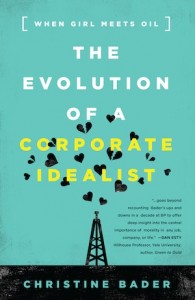 As various people from my network tweeted about it, I got intrigued and pre-ordered a copy of Christine Bader’s book The Evolution of a Corporate Idealist. Once I started reading it, I could not put it down! I generally read non-fiction at my desk, but this book I read on the couch, in bed, on holidays and at my desk. I finished it in less than two weeks, which is rare for me for a non-fiction book.
As various people from my network tweeted about it, I got intrigued and pre-ordered a copy of Christine Bader’s book The Evolution of a Corporate Idealist. Once I started reading it, I could not put it down! I generally read non-fiction at my desk, but this book I read on the couch, in bed, on holidays and at my desk. I finished it in less than two weeks, which is rare for me for a non-fiction book.
The book closes with her manifesto for the corporate idealist – which also makes a perfect structure to write down my thoughts about the book and activation of sustainable business practices in general.
1. What is good for society is good for my company.
Finding the way to create shared value for both society and business is the way forward. There’s a role of philanthropy, but the true power of business to have a positive impact on society is unlocked when that positive impact is built into its business model. Only then is change sustainable, as shown by numerous examples in the book. But even if you don’t find that shared value sweet spot, doing the right thing for society is usually good for business, as it can help prevent a lot of trouble (which may not always be recognized, though).
2. Responsible business should be redundant.
Business can be such a powerful driver for good, but many people inside and outside of companies predominantly associate it with “bad things” like greed, waste, exploitation of resources and people. Most businesses started to meet a consumer/customer need, taking responsibility to resolve that need, not to intentionally do harm. As shown in the book, it’s time for business and brands to rethink, to redesign their purpose, their ways – and come up with new business models that meet current and future needs – of consumers, customers and society at large. Then all business would be responsible by design.
3. Sharing stories of the people and communities my company affects is part of my job.
Communication is key in driving change. Internally to create commitment and engage the relevant people to change happen, externally to raise awareness of the efforts and challenges, to generate a balanced story that fosters trust. The stories in the book highlight that you can never assume people will understand or even know about these type of efforts – without investing further efforts in good storytelling.
4. Evangelizing to my colleagues is not helpful. Figuring out how my work supports theirs is.
The happiest (and perhaps most effective) corporate idealists I’ve met are all close to the business, and are very well able to connect sustainability to the business model and success drivers of the company. Otherwise, you risk becoming a nagging creature like Dr. Seuss’ Lorax, a voice for the trees and the cuddly creatures, peripheral to the core of the business. This message of placing sustainability in the core of the business also comes through clearly in SAP’s open online course on sustainability.
5. The “business case” is important. So is morality.
To drive change and integrate sustainability into the business model and strategy, it is indeed paramount to define the “business case” for sustainability. But not at any price, not without an authentic core that fits with the company’s purpose and values. Without that, sustainability programs can easily become PR gimmicks and/or window-dressing, which over time can backlash and have a negative effect.
6. Leadership transitions and financial downturns are irrelevant if I’ve truly embedded my work.
Who can disagree to this, but I’m afraid that even in the companies leading the pack today, leadership changes can still have a huge influence as sustainability and the changes needed are a moving target, a continuous work in progress. Christine Bader’s insider perspectives on BP’s change in leadership in a tough financial situation show just how much there’s still left to do.
7. All human rights are relevant to my company.
Christine Bader’s stories of moving an entire village in Indonesia and the numerous stories shared by other corporate idealists in the book paint the challenges of Human Rights in the supply chain. One of my corporate idealist friends working in finance rebutted his board very well when they challenged him on the relevance of human rights in their line of business: “And how do we know that our offices in Asia aren’t cleaned by children or forced labor?” That question changed his remit forever!
8. If consultation and collaboration aren’t both frustrating a worthwhile, I’m not doing it right.
From corporate idealists around the world, I’ve heard this mantra again and again – this is their daily plight. In Dutch, there is a saying “there is no shine without friction” – which we repeated often during the development process of G4 at GRI, working with hundreds of experts, thousands of stakeholders and even more opinions, ideas and suggestions. Everything worth doing is going to be difficult; if it isn’t, you’re not challenging yourself enough. As if the corporate idealists needed any more challenge, but so very true!
9. Transformational change is needed. Incremental change is good too.
Big change is needed to resolve the big challenges in our society, on our planet, but big change is almost always very scary and difficult. Small changes add up, and even if they do not add up to a significant enough amount of change, their biggest contribution may be in making people experience that change is possible – getting them ready for the much needed bigger changes.
10. The changes we face are systemic and complex. But that doesn’t mean I can’t do anything about them.
Especially the first two-thirds of the book are written in this spirit – sharing her own stories of driving change within BP and the stories of many other corporate idealists from her network. Showing that you can make a difference, even in huge companies. Towards the end of the book, the story seems a bit gloomy, less optimistic, highlighting the struggles and the wish list of corporate idealists. True to point #3 of her manifesto, providing a balanced perspective. But then the end is optimistic again – closing on the beauty of the network of corporate idealists around the world, coming together at conference from time to time to learn from and inspire each other.
Maybe that’s what added to the joy of reading this book, the personal anecdotes from her network. I’ve met several of the people quoted, or seen them speak at the numerous sustainability conference I spoke at around the world. It’s a wonderful tribe of people, running programs big and small, driving change for a better world. I hope this book inspires them to keep going – and new talent to join this growing group of activists!
To find out more about Christine Bader and her work, please visit her website.

RT @MBaghuis: New on my blog: Activating Corporate Idealists – or Idealizing Corporate Activists? review of @christinebader ‘s book http://…
RT @bcsrdak: Activating Corporate Idealists – or Idealizing Corporate Activists? http://t.co/On5bKKKvzJ
Activating Corporate Idealists – or Idealizing Corporate Activists? http://t.co/On5bKKKvzJ
New on my blog: Activating Corporate Idealists – or Idealizing Corporate Activists? review of @christinebader ‘s book http://t.co/1TPMR5rRHJ